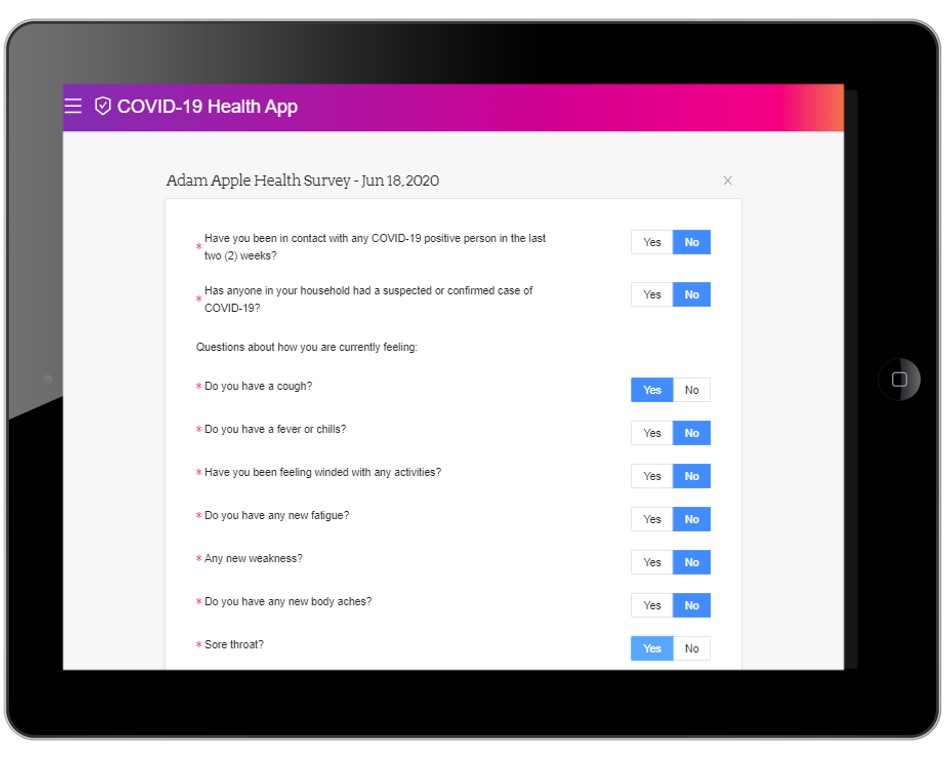On July 13, New York State released interim guidance on reopening K-12 schools this Fall. The document outlines plan requirements for schools to re-open, and can be read in full here.
Below, we'll discuss the main points and plan requirements outlined in the document, and some tools you can use to help implement your plan. This article does not replace the full guidance released by your local authorities, and you should refer to the full, published outlines released by local and state officials, while creating your reopening plans.
- Health Screening / Temperature Checks
Schools in New York State are required to implement daily health screening and temperature checks. Schools are strongly recommended to provide this screening digitally, allowing parents and staff to complete the screening from home. The screening should be used to identify individuals who should not come to school, based on contact with anyone positive or showing symptoms of COVID-19, travel in certain areas, showing symptoms consistent with COVID-19 (including a temperature of 100.0°F or more in the past 14 days), or has tested positive for COVID-19.
ParentLocker's Health Screening Tool allows students (or parents of young students) and staff to submit a daily health questionnaire. Temperature Checks can be inputted into the system as well. Screening results (ie cleared/not cleared) can be queried in SIS data reports and are visible to school administrators and teachers. The questions in your school's questionnaire, as well as the responses which trigger a "not cleared," can be customized by your school.
- Metrics
Results of the daily health screening can be aggregated on reports by class, day, week, etc, to help identify increased transmission beyond an acceptable level within school. Schools should have a plan for what constitutes an "acceptable level" and what happens when increased transmission is identified. - Social Distancing
Students, teachers and other individuals at school must practice strict social distancing. Guidance regarding face coverings / PPE for students and staff is nuanced and you should refer to your local guidance when making a decision regarding masks for students. Certain activities, like singing, require more stringent social distancing. Students and staff should be trained to practice proper hand-washing and self-sanitation. - Space Configurations
Schools are encouraged to reconfigure spaces to reduce areas where students and staff can gather, as well as enable more space for smaller cohorts of students. Consider using open areas, or outdoor areas (weather permitting) for in-person instruction. When possible, windows should be opened to provide fresh air ventilation in the space. - Staggered Schedules
Where possible, schedules should be adjusted to allow for staggered arrival and pick-up times. In ParentLocker, schedules can be individualized for each student. Schedule templates can be created per class, so each class can have their own designated arrival and pick-up times. To learn more about creating schedule templates, please refer to this guide, or contact support@parentlocker.com. - Cohorts and Limiting Contact
Schools should consider creating "cohorts," self-contained, pre-assigned groups of students with reasonable group size limits. Contact between cohorts should be reduced to a minimum, and should remain fixed for the duration of the pandemic. ParentLocker supports creating cohorts, or class sections, for use in scheduling and communication via the system. To learn more about assigning students to a section/cohort, refer to this guide. - Cleaning and Disinfecting
There are strict requirements for ensuring proper hygiene and disinfection on campus, especially in bathrooms, food service, and communal areas. Students and staff should be trained to practice proper hand-washing and self-sanitation. Hand sanitizer and disinfecting wipes can also be provided in communal areas and for equipment like shared computers, and cleaning/disinfection logs should be kept for each facility. Additional guidance is provided for disinfecting areas where an individual confirmed to have COVID-19 is located. - Communication
Schools must engage with parents and staff regarding re-opening plans, updated rules and guidelines, and prevention efforts. Furthermore, applicable instruction and training must be provided to parents; for example, you can communicate the importance of staying home if you may be sick. In NY, a COVID-19 safety coordinator must be designated per school, whose responsibilities include continuous compliance with all guidelines. ParentLocker can be used to provide robust and instant communication with your community, via email, text message, or the homepage Newsfeed. - Plans and Training
- Students and staff should be trained to practice proper hand-washing and self-sanitation.
- The school should communicate the importance of staying home if one feels unwell or may have been exposed.
- Staff should be trained to inspect students (especially young students) for signs of illness, which could include flushed cheeks, rapid or difficulty breathing,or fatigue. Schools should also maintain logs or essential visitors who were in close contact with any students.
- Your school should have a plan in place if a student or staff member is diagnosed with COVID-19. At a minimum, health authorities must be notified, all facilities the individual must be deep-cleaned, and any students or staff who were in close contact should quarantine for 14 days and self-monitor.
- Your school should have a plan in place in case of high transmission rates at school, and plans for remote learning should be in place.
- Your school should have a plan in place regarding returning to school after being sick with COVID-19.